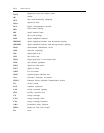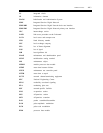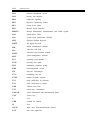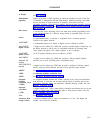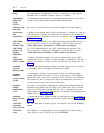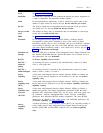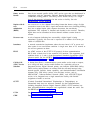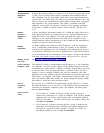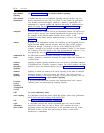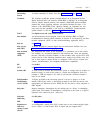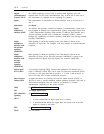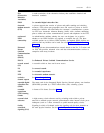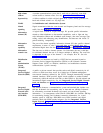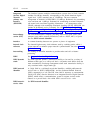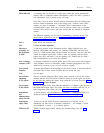
GL-6 GLOSSARY
clear-channel
signaling
clear channel
transmission
codepoint
codeset
combination tie
trunk
common-
channel
interoffice
signaling
common-
channel
signaling
Common-
Control
Switching
Arrangement
(CCSA)
CRC
cross coupling
CSU
cyclic
redundancy
check (CRC)
See 24th-channel signaling and common-channel signaling.
A channel that does not use robbed-bit signaling and does not have the ones-
density requirement for user data. For System 75 and System 85 applications,
clear channel transmission happens whenever a channel’s signaling bits are
transmitted in a separate channel and whenever the facility is administered for
B8ZS line coding. See also 24th-channel signaling, restricted channel, and
unrestricted digital data.
A numeric value for a specific field of an information element (IE) and used as
part of a Q.931 message, thus allowing identification and processing of the IE.
For example, in the network-specific facilities IE, the value 1 in the
feature/service field means that the requested facility is a service. See also Q.930
and Q.931 .
A group of 133 information element (IE) identifiers. In the Integrated Services
Digital Network (ISDN) message structure, there are eight possible codesets,
numbered 0 through 7. Codeset 0 is the set of IEs defined by the CCITT.
Codesets 1 through 4 are reserved for future standards. Codeset 5 is for national
use. Codeset 6 is for IEs specific to the local serving network. Codeset 7 is for
user-specific IEs. See also AT&T standardized facility element.
An end-to-end transmission facility consisting of both digital and analog
facilities. Generally, combination tie-trunks are digital trunks that terminate on
a channel bank.
Signaling in which signaling information for each of the 23 information channels
is multiplexed into a separate "common" channel. For AT&T products, the 24th
channel is used as the common channel. See also signaling system number 7.
Signaling in which one channel of 24 carries signaling for the other 23 channels,
permitting channels to be used to nearly full capacity. Also called alternate
voice/data signaling, clear-channel signaling, or out-of-band signaling. See also
24th-channel signaling and clear-channel signaling.
A private telecommunications network using dedicated trunks and a shared
switching center for interconnecting company locations.
See cyclic redundancy check.
In a duplicated system, the process where the off-line system clock synchronizer
(SCS) checks the signal integrity of the on-line SCS.
See network channel-terminating equipment.
A verification protocol that ensures transmitted data was received without
transmission errors. Data are sent in blocks. CRC compares the block’s
appearance before and after transmission. If the appearance does not match,
that block of data is resent. Data will usually be resent 10 times before
transmission is abandoned.



